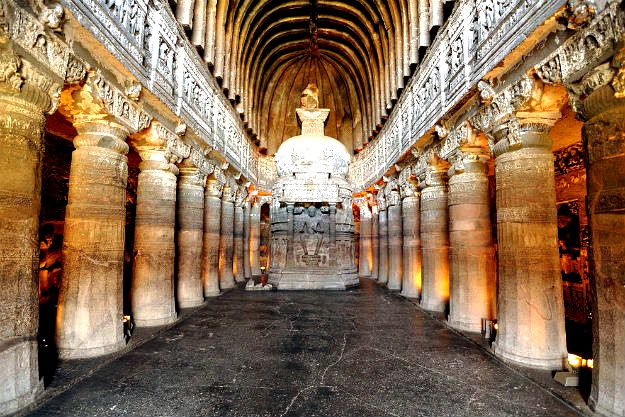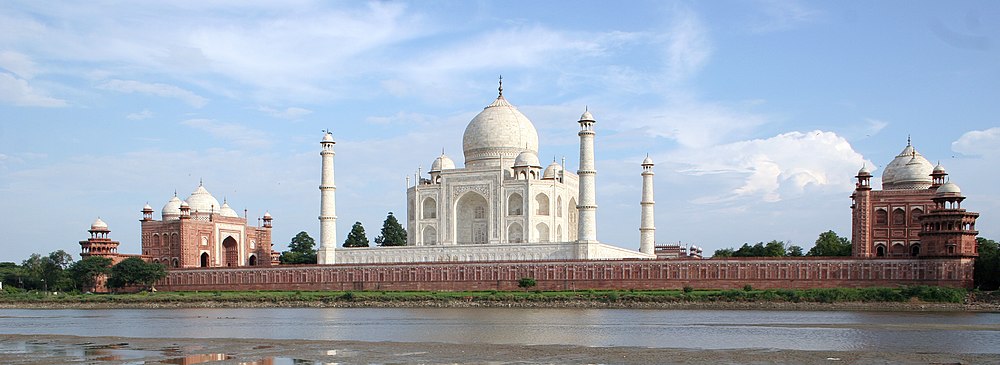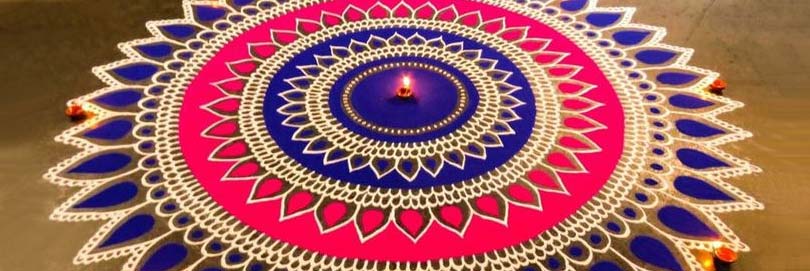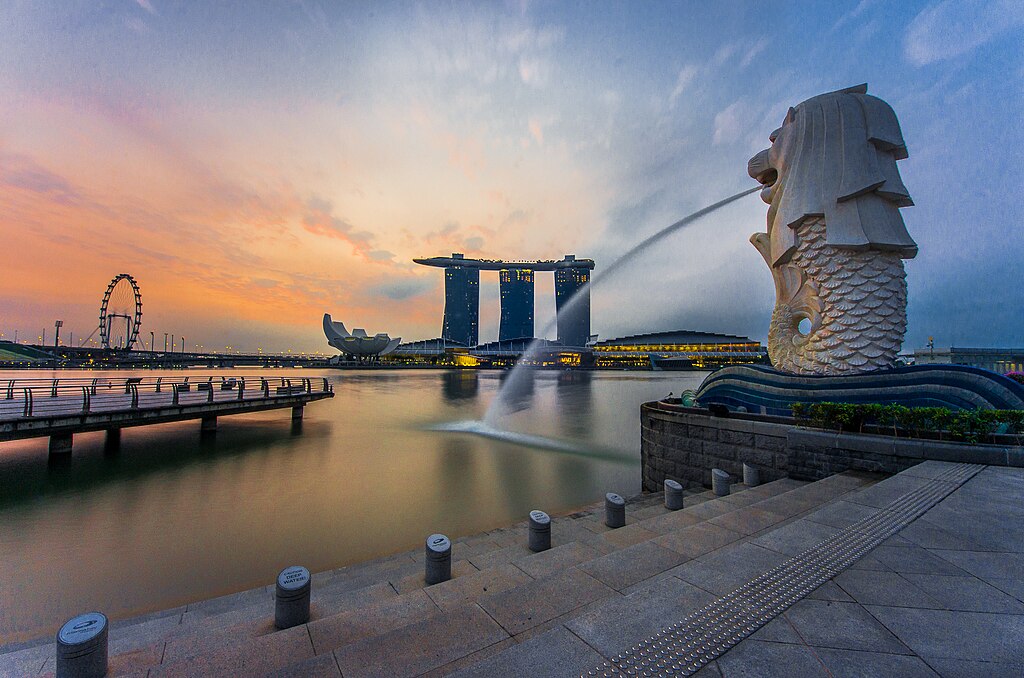LESSON 1: Periods of
Indian Art
· Ancient Period (3900 BCE-1200 CE)
Some evidences of the early civilization
are bronze and copper statuettes and steatite
seals, which show vigor and concern for
surface texture as constantly characterized in
Indian art.
· Ancient Period (3900 BCE-1200 CE)
Some evidences of the early civilization
are bronze and copper statuettes and steatite
seals, which show vigor and concern for
surface texture as constantly characterized in
Indian art.
The Ajanta Caves of
Maharashtra, India are 30 rock-cut cave
monuments that date back from the 2nd
century BCE to the 600 CE, including
paintings and sculptures considered to be
masterpieces of Buddhist religious art , as
well as frescos that are reminiscent of
the Sigiriya paintings in Sri Lanka.


Classical Period ( 5th to 6th centuries)
The image of Shiva (as illustrated in the picture), the destroyer, develops into Shiva the Cosmic-dancer represented by a four-armed figure, where one hand holds
the fire with which he destroys, another holds a drum, which is the first sound heard in the world during creation, then the third arm points up in a reassuring gesture, and a
fourth arm points down to the dwarf in which he dances to.
· Islamic Ascendancy (1192-1757) or Transitional Period
This was the period of evolution from Vedism into Hinduism or Brahmanism. The two
great Indian epics: the Mahabharata and the Ramayana emerged in this period.
252 · Mogul period ( 16th Century)
Moguls contributed to the enrichment of
Indian culture, in painting and in architecture.
The most splendid example is the Taj Majal built in 1632 by Shah Jahan in memory of his wife.
The image of Shiva (as illustrated in the picture), the destroyer, develops into Shiva the Cosmic-dancer represented by a four-armed figure, where one hand holds
the fire with which he destroys, another holds a drum, which is the first sound heard in the world during creation, then the third arm points up in a reassuring gesture, and a
fourth arm points down to the dwarf in which he dances to.
· Islamic Ascendancy (1192-1757) or Transitional Period
This was the period of evolution from Vedism into Hinduism or Brahmanism. The two
great Indian epics: the Mahabharata and the Ramayana emerged in this period.
252 · Mogul period ( 16th Century)
Moguls contributed to the enrichment of
Indian culture, in painting and in architecture.
The most splendid example is the Taj Majal built in 1632 by Shah Jahan in memory of his wife.

Diwali is celebrated by Hindus in
India and all around the world in October
or November. It is the Hindu New Year
and is either a 3-day or 5-day holiday
depending on where you come from.
It is a very exciting and colorful holiday,
where homes are cleaned to welcome
the New Year and windows are opened
so that the Hindu goddess of wealth,
Lakshmi, can enter. Hindus believed that she cannot enter a house which is not lit up,
so every household burns special Diwali clay lamps (diyas) to light the way for the goddess, which is why the holiday is
also known as the 'Festival of Lights'.
https://join-adf.ly/17169831
https://join-adf.ly/17169831LESSON 2: RANGOLI
Rangoli is one of the most beautiful and most pleasing art forms of India. It is
comprised of two words:'rang' meaning 'color' and 'aavalli' meaning 'colored creepers' or 'row of colors'. Rangoli, the art of making designs or patterns on the walls or the floor of
the house, uses finely ground white powder
along with different colors. Numerous
households in the Indian subcontinent make
use of Rangoli designs for decorating the
courtyard of their house.

The traditional form of Rangoli made use of designs and motifs based on nature, such as mangoes, creepers, flowers, swans, peacocks, etc. Even the colors in the traditional art form were extracted from natural dyes, like barks of trees, leaves,
indigo plant, etc. These days, synthetic
dyes have more or less replaced the natural dyes of the earlier times.
The materials used in the Rangoli patterns of today give either a very flat
appearance or a 3-D effect. Rangoli designs include geometric patterns, the swastika,
lotus, trident, fish, conch, creepers, leaves, trees, flowers, animals, etc.
254 LESSON 3: PAKISTAN
Pakistani architecture is divided into four
recognized periods:
· Pre-Islamic
· Islamic The arrival of Islam in today's Pakistan - first in Sindh - during the 8th century AD meant a sudden end of Buddhist architecture. However, a smooth transition to predominantly pictureless Islamic architecture occurred. The way early mosques were built with decorations oriented them strongly to the Arab style. The earliest example of a mosque from the days of infancy of Islam in South Asia is the Mihrablose mosque of Banbhore, from the year 727, the first Muslim place of worship in South Asia. Under the Delhi Sultan the Persian-centralasiatic style ascended over Arab influences. Most important characteristic of this style is the Iwan, walled on three sides, with one end entirely open. Further characteristics are wide prayer halls, round domes with mosaics and geometrical samples and the use of painted tiles. The most important of the few completely discovered buildings of Persian style is the tomb of the Shah Rukn-i-Alam (built 1320 to 1324) in Multan. At the start of the 16th century, the Indo-Islamic architecture was at the height of its boom. During the Mughal era design elements of Islamic-Persian architecture were fused with and often produced playful forms of the Hindustani art. Lahore, occasional residence of Mughal rulers, exhibits a multiplicity of important buildings from the empire, among them the Badshahi mosque (built 1673-1674), the fortress of Lahore (16th and 17th centuries) with the famous Alamgiri Gate, the colourful, the Wazir Khan Mosque,[4] (1634-1635) as well as numerous other mosques and mausoleums. Also the Shahjahan Mosque of Thatta in Sindh originates from the epoch of the Mughals. However, it exhibits partially different stylistic characteristics. Singularly, the innumerable tombs of the Chaukhandi are of eastern influence. Although constructed between 16th and 18th centuries, they do not possess any similarity to Mughal architecture. The stonemason works show rather typical Sindhi workmanship, probably from before Islamic times. The building activity of the Mughals came close to succumbing by the late 18th century. Afterwards hardly any special native architectural projects were undertaken.
· Colonial In the British colonial age predominantly representative buildings of the Indo-European style developed, from a mixture of European and Indo-Islamic components. Amongst the more prominent works are Mohatta Palace and Frere Hall in Karachi.
· Post-Colonial After independence Pakistan strove to express its newly found national identity through architecture. This reflects itself particularly in modern structures like the Faisal Mosque in Islamabad. In addition, buildings of monumental importance such as the Minar-e-Pakistan in Lahore or the mausoleum established with white marble known as Mazar-e-Quaid for the founder of the state expressed the self-confidence of the nascent state. The National Monument in Islamabad is one of the latest examples of integrating culture, independence and modern architecture.
Around the middle of the 3rd millennium
BCE, an advanced urban culture developed
for the first time in the region, with large
buildings, some of which still survive to this
day likeMohenjo Daro, Harappa,and Kot
Diji which areamong the pre-Islamic
settlements that are now tourist attractions.
Archaeologists excavated numerous ancient cities, among them Mohenjo Daro, Harrappa and Kot Diji, which have a uniform, appropriate structure with broad roads as well as well thought out sanitary and drainage facilities. The majority of the discovered brick constructions are public buildings such as bath houses and workshops. Wood and loam served as construction materials. Large scale temples, such as those found in other ancient cities are missing. With the collapse of the Indus Valley civilization the architecture also suffered considerable damage.[3] View of Mohenjo-Daro towards the Great Bath.
Unfortunately little is known about this civilization, often called Harappan, partly because it disappeared about 1700 BC for reasons unknown and because its language remains undeciphered; its existence was revealed only in the midst of the 19th century (your text says the 1920s), and excavations have been limited. Surviving evidence indicates a sophisticated civilization. Cities like Harappa and Mohenjo-Daro (the "City of the Dead") had populations of some 35,000, they were laid out according to grid system. Inhabitants lived in windowless baked brick houses built around a central courtyard. These cities also had a citadel, where the public and religious buildings were located, large pools for ritual bathing, granaries for the storage of food, and a complex system of covered drains and sewers. The latter rivaled the engineering skill of the Romans some 2,000 years later
Across Pakistan, brightly colored flamboyant trucks, painted with images of
idealized landscapes, famous personalities, flowers, and trees, turned village lanes,
city streets, and long-distance highways into a gallery without walls; a free-form,
kaleidoscopic exhibition in motion.
LESSON 4: UZBEKISTAN, KAZAKHSTAN, TAJIKISTAN
People who inhabited the region of present
Uzbekistan are known for making printed cloth. Printed table-cloths, curtains, bed-spreads, shawls and various coverlets were utilitarian and served as a daily-round
ornament as well.
Uzbekistan ceramics hold a prominent place
among the numerous forms of popular applied art. Applied arts in ancient Kazakhstan were part of life’s daily routine.
Clothing, utility tools, yurts, and horses’ saddles were always decorated using nomadic patterns and design.
Kazakhstan’s visual arts are relatively young. In ancient times, nomads used to draw on rocks and, today, these petroglyphs can be found throughout Kazakhstan.
Fine art in Kazakhstan varies in style, direction, and genre. The most captivating work by Kazakhstan artists in different periods can be seen in museums across the country.
Tajiks have been making fabrics, utensils,
musical instruments, carpets, furniture,
jewelry, and many other things for many
centuries. The art of decorative carving is very important for local residents. Carving is
mostly present in architectural monuments,
household structures and objects, musical
instruments, and souvenirs. When Islam came, Tajik’s carving gradually changed to Arabian inscriptions using images of people and animals while some carvers prefer “vegetative,” geometrical patterns. In architecture, ornaments in the form of lotus, tulips, and other flowers are more common.
257
LESSON 5: TURKMENISTAN AND KYRGYSTAN
The most unique and beautiful carpets in the world are produced by Turkmenistan. These vary in shape and purpose. Carpet weaving
is an ancient art, and each tribe developed its own distinctive pattern. The traditional arts include felt manufacture, jewelry making, woodwork, ceramics, and silverwork.
Turkmen carpets have been traditionally woven out of wool, cotton, and silk by women, using horizontal looms. The method of weaving has been modernized,
but the beauty and quality of the fabrics remain. Turkmenistan is also the source of keteni, a homespun silk that is used for the beautiful dresses worn by Turkmen women on special occasions. The embroidery uses different patterns that are as unique as a family seal.
"KETENI" CLOTH IS AN OBJECT OF ONE OF THE WONDERFUL TRADITIONS OF THE TURKMEN PEOPLE
Kyrgyz women produce a wide
range of textiles, mostly from the felt of
their sheep. Nowadays ancient patterns
are adapted to the tourist and export
market, but it is still a living tradition and
that all yurts and most houses contain
hand-made carpets or rugs called
shirdaks.
Let’s now visit the neighboring countries of Uzbekistan, Kazakhstan and Tajikistan
258
Large elaborately embroidered wall hangings
called Tush kyizare traditionally made in Kyrgyzstan and Kazakhstan, by elder women to commemorate the marriage of a son or daughter. Colors and designs are chosen to symbolize Kyrgyz traditions and rural life. Flowers, plants, animals, stylized horns, national designs, and emblems of Kyrgyz life are often found in these ornate and colorful embroideries.
Flat cushions called xxx are usually made in
shadow-pairs. These are seen on every chair,
padding the seat.
LESSON 6: ARTS AND CRAFTS OF WEST ASIA
West Asia is rich in cultural heritage, and this
is clearly evident in the variety and quality of
regional arts and crafts.
259
Typical artistic forms from the region include:
· embroidery
· ceramics
· wood carving
· inlaid wood designs
· Calligraphy
· hammered metalwork
· blown glassworks
· Although these are some of
the most acclaimed art forms
contributed by West Asia, their
aesthetics can be seen in almost
any product from the region
even including such things as
handmade soap from Syria or
Lebanon.























